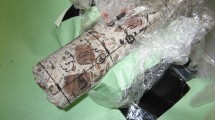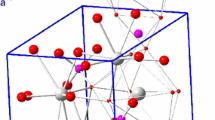Abstract
During the optimization of 36Cl determination in solid wastes from nuclear decommissioning, a residual 36Cl signal was observed in procedural blanks measured after processing active samples. To uncover the possible causes, we investigated the interaction of chlorine with the components of a Pyrolyser-6 Trio™, as well as the chemicals used during the procedure. Different treatments for identifying the source of chlorine carryover were thoroughly investigated, demonstrating that the 36Cl memory effect arises from the interaction with pyrolyser components and that it occurs almost every time when the analysis procedure is performed. Therefore, results obtained using this analysis procedure need to be corrected for this memory effect by measuring procedural blank samples before and after measuring 36Cl-containing samples.











Similar content being viewed by others
References
Ojovan MI (2011) Radioactive waste characterization and selection of processing technologies. Handbook of advanced radioactive waste conditioning technologies. Woodhead Publishing Limited, Sawston, pp 1–16
The International Atomic Energy Agency (IAEA) (2004) Application of the concepts of exclusion, exemption and clearance (IAEA RS-G-1.7). Vienna, Austria
Taddei MHT, Vicente R, Marumo JT, Sakata SK, Terremoto LAA (2013) Determination of long-lived radionuclides in radioactive wastes from the IEA-R1 nuclear research reactor. J Radioanal Nucl Chem 295:951–957. https://doi.org/10.1007/s10967-012-1865-0
Croudace I, Warwick P (2013) Application of thermal desorption techniques to the characterisation of nuclear decommissioning wastes. In: 2nd NKS‐B workshop on radioanalytical chemistry. Roskilde, Denmark, pp 1–17
Hou X, Roos P (2008) Critical comparison of radiometric and mass spectrometric methods for the determination of radionuclides in environmental, biological and nuclear waste samples. Anal Chim Acta 608:105–139. https://doi.org/10.1016/j.aca.2007.12.012
Hou X, Olsson M, Togneri L, Englund S, Vaaramaa K, Askeljung C, Gottfridsson O, Hirvonen H, Öhlin H, Forsström M, Anders F, Lampén M, Hatakka A (2016) Present status and perspective of radiochemical analysis of radionuclides in Nordic countries. J Radioanal Nucl Ccslhemistry 309:1283–1319. https://doi.org/10.1007/s10967-016-4741-5
Hou X (2007) Radiochemical analysis of radionuclides difficult to measure for waste characterization in decommissioning of nuclear facilities. J Radioanal Nucl Chem 273:43–48. https://doi.org/10.1007/s10967-007-0708-x
Räty A, Lavonen T, Leskinen A, Likonen J, Postolache C, Fugaru V, Bubueanu G, Lungu C, Bucsa A (2019) Characterization measurements of fluental and graphite in FiR1 TRIGA research reactor decommissioning waste. Nucl Eng Des 353:110198. https://doi.org/10.1016/j.nucengdes.2019.110198
Croudace IW, Russell BC, Warwick PW (2017) Plasma source mass spectrometry for radioactive waste characterisation in support of nuclear decommissioning: a review. J Anal At Spectrom 32:494–526. https://doi.org/10.1039/c6ja00334f
Rodríguez M, Piña G, Lara E (2006) Radiochemical analysis of chlorine-36. Czechoslov J Phys 56:211–217. https://doi.org/10.1007/s10582-006-0507-6
Ashton L (2000) Determination of 36Cl and other long-lived radionuclides in decommissioning concrete wastes. Thesis. Loughborough University
Ashton L, Warwick P, Giddings D (1999) The measurement of 36Cl and 129I in concrete wastes. Analyst 124:627–632. https://doi.org/10.1039/a809292c
Hummel W (2017) Chemistry of selected dose-relevant radionuclides. NAGRA Technical Report 17-05. Wettingen Switzerland
Hou X (2013) Determination of pure beta emitters using LSC for characterization of waste from nuclear decommissioning. In: Advances in liquid scintillation spectrometry (LSC 2013). Barcelona
Warwick P, Reading D, Croudace I (2010) Measurement of 36 Cl and 129 I in decommissioning wastes. In: Triskem international. Southampton
Llopart Babot I, Vasile M, Dobney A, Boden S, Bruggeman M, Leermakers M, Qiao J (2022) On the determination of 36Cl and 129I in solid materials from nuclear decommissioning activities. J Radioanal Nucl Chem. https://doi.org/10.1007/s10967-022-08327-9
Fréchou C, Degros JP (2005) Measurement of 36Cl in nuclear wastes and effluents: Validation of a radiochemical protocol with an in-house reference sample. J Radioanal Nucl Chem 263:333–339. https://doi.org/10.1007/s10967-005-0059-4
Rahim MU, Gao X, Wu H (2013) A method for the quantification of chlorine in low-rank solid fuels. Energy Fuels 27:6992–6999. https://doi.org/10.1021/ef401080x
Rahim MU (2014) Quantification of chlorine in solid fuels and its release behaviour during pyrolysis. Thesis. Chapter 2. Curtin University
Hou X, Østergaard LF, Nielsen SP (2007) Determination of 36Cl in nuclear waste from reactor decommissioning. Anal Chem 79:3126–3134. https://doi.org/10.1021/ac070100o
Roman D, Airey PL (1981) The application of environmental chlorine-36 to hydrology-I. Liquid scintillation counting. Int J Appl Radiat Isot 32:287–290. https://doi.org/10.1016/0020-708x(81)90087-9
Tolmachyov S, Ura S, Momoshima N, Yamamoto M, Maeda Y (2001) Determination of 36 Cl by liquid scintillation counting from soil collected at the semipalatinsk nuclear test site. J Radioanal Nucl Chem 249:541–545. https://doi.org/10.1023/a:1013281812005
Itoh M, Watanabe K, Hatakeyama M, Tachibana M (2002) Determination of 36Cl in biological shield concrete using pyrohydrolysis and liquid scintillation counting. Analyst 127:964–966. https://doi.org/10.1039/b200250g
Cecil LDW, Welhan JA, Green JR, Frape SK, Sudicky ER (2000) Use of chlorine-36 to determine regional-scale aquifer dispersivity, eastern Snake River Plain aquifer, Idaho/USA. Nucl Instrum Methods Phys Res Sect B Beam Interact Mater Atoms 172:679–687. https://doi.org/10.1016/S0168-583X(00)00216-0
Baxter M, Castle L, Crews HM, Rose M, Garner C, Lappin G, Leong D (2009) A sensitive method for the determination of chlorine-36 in foods using accelerator mass spectrometry. Food Addit Contam Part A 26:139–144. https://doi.org/10.1080/02652030802342489
Andrews HR, Ball GC, Brown RM, Cornett RJJ, Davies WG, Greiner BF, Imahori Y, Koslowsky VT, McKay J, Milton GM, Milton JCD, Allen KW (1990) Development of the Chalk River program for 36Cl. Nucl Instrum Methods Phys Res Sect B Beam Interact Mater Atoms 52:243–248. https://doi.org/10.1016/0168-583X(90)90414-P
Nagashima Y, Seki R, Takahashi T, Arai D (2000) Status of the 36Cl AMS system at the University of Tsukuba. Nucl Instrum Methods Phys Res Sect B Beam Interact Mater Atoms 172:129–133. https://doi.org/10.1016/S0168-583X(00)00208-1
Pavetich S, Akhmadaliev S, Arnold M, Aumaître G, Bourlès D, Buchriegler J, Golser R, Keddadouche K, Martschini M, Merchel S, Rugel G, Steier P (2014) Interlaboratory study of the ion source memory effect in 36Cl accelerator mass spectrometry. Nucl Instrum Methods Phys Res Sect B Beam Interact Mater Atoms 329:22–29. https://doi.org/10.1016/j.nimb.2014.02.130
Karhu H, Kalantar A, Väyrynen IJ, Salmi T, Murzin DY (2003) XPS analysis of chlorine residues in supported Pt and Pd catalysts with low metal loading. Appl Catal A Gen 247:283–294. https://doi.org/10.1016/S0926-860X(03)00098-X
Halonen I, Tarhanen J, Ruokojärvi P, Tuppurainen K, Ruuskanen J (1995) Effect of catalysts and chlorine source on the formation of organic chlorinated compounds. Chemosphere 30:1261–1273. https://doi.org/10.1016/0045-6535(95)00022-Z
Dai J, Whitty KJ (2020) Impact of fuel-derived chlorine on CuO-based oxygen carriers for chemical looping with oxygen uncoupling. Fuel 263:116780. https://doi.org/10.1016/j.fuel.2019.116780
Le Dizès S, Gonze MA (2019) Behavior of 36Cl in agricultural soil-plant systems: a review of transfer processes and modelling approaches. J Environ Radioact 196:82–90. https://doi.org/10.1016/j.jenvrad.2018.10.011
Strömberg B, Zintl F (2008) Release of chlorine from biomass and model compounds at pyrolysis and gasification conditions. Prog Thermochem Biomass Convers 0624:1234–1245. https://doi.org/10.1002/9780470694954.ch102
Warwick PE, Zulauf A, Happel S, Croudace IW (2010) Determination of 36Cl in decommissioning samples using a Pyrolyser furnace and extraction chromatographic separations. In: Triskem international. Southampton
Johansen JM, Jakobsen JG, Frandsen FJ, Glarborg P (2011) Release of K, Cl, and S during pyrolysis and combustion of high-chlorine biomass. Energy Fuels 25:4961–4971. https://doi.org/10.1021/ef201098n
Galan I, Glasser FP (2015) Chloride in cement. Adv Cem Res 27:63–97. https://doi.org/10.1680/adcr.13.00067
Croudace IW, Warwick PE, Marsh R (2017) A suite of robust radioanalytical techniques for the determination of tritium and other volatile radionuclides in decommissioning wastes and environmental matrices. Fusion Sci Technol 71:290–295. https://doi.org/10.1080/15361055.2017.1293450
Von Lensa W, Vulpius D, Steinmetz HJ, Girke N, Bosbach D, Thomauske B, Banford AW, Bradbury D, Grave MJ, Jones AN, Grambow B, Petit L, Pina G (2013) Treatment and disposal of irradiated graphite and other carbonaceous waste. Carbowaste report. Mol
IUPAC (2014) Compendium of chemical terminology. Version 2.3.3. In: Gold book. pp 135–151
Chen X, Xu Z, Yang F, Zhao H (2019) Flame spray pyrolysis synthesized CuO-TiO2 nanoparticles for catalytic combustion of lean CO. Proc Combust Inst 37:5499–5506. https://doi.org/10.1016/j.proci.2018.05.102
Juang RS, Lee TS (2002) Oxidative pyrolysis of organic ion exchange resins in the presence of metal oxide catalysts. J Hazard Mater 92:301–314. https://doi.org/10.1016/S0304-3894(02)00025-0
Siwadamrongpong S, Koide M, Matusita K (2004) Prediction of chloride solubility in CaO-Al2O 3-SiO2 glass systems. J Non Cryst Solids 347:114–120. https://doi.org/10.1016/j.jnoncrysol.2004.07.063
Watanabe N, Tanikawa N, Oikawa T, Inoue S, Fukuyama J (2003) Improved quartz furnace method for chlorine and sulfur determination in municipal solid waste. J Mater Cycles Waste Manag 5:69–76. https://doi.org/10.1007/s101630300011
Anderson GM, Burnham CW (1967) Reactions of quartz and corundum with aqueous chloride and hydroxide solutions at high temperatures and pressures. Am J Sci 265:12–27. https://doi.org/10.2475/ajs.265.1.12
Acknowledgements
I would like to thank ENGIE for sponsoring this project. We would also like to thank the LSC laboratory team at SCK CEN for their support.
Funding
No funding was received to assist with the preparation of this manuscript. The authors have no relevant financial or non-financial interests to disclose.
Author information
Authors and Affiliations
Corresponding author
Additional information
Publisher's Note
Springer Nature remains neutral with regard to jurisdictional claims in published maps and institutional affiliations.
Rights and permissions
Springer Nature or its licensor holds exclusive rights to this article under a publishing agreement with the author(s) or other rightsholder(s); author self-archiving of the accepted manuscript version of this article is solely governed by the terms of such publishing agreement and applicable law.
About this article
Cite this article
Llopart-Babot, I., Vasile, M., Dobney, A. et al. Investigating the 36Cl memory effect in pyrolysis of solid samples from nuclear decommissioning activities. J Radioanal Nucl Chem 331, 4239–4249 (2022). https://doi.org/10.1007/s10967-022-08492-x
Received:
Accepted:
Published:
Issue Date:
DOI: https://doi.org/10.1007/s10967-022-08492-x




